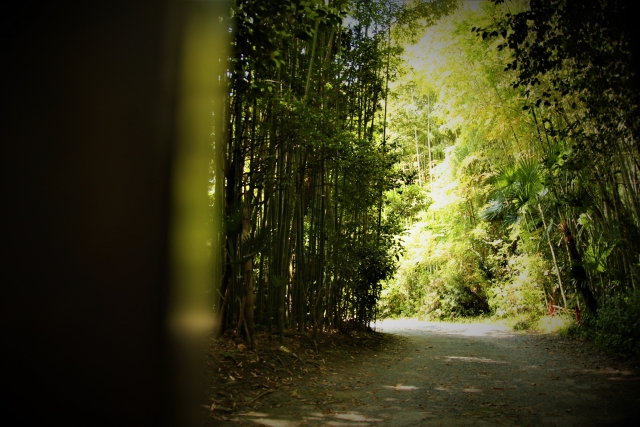The Seasonal Travels of Tottori
Top photo: Toby Sakata on Unsplash
Home to about 10 percent of Japan’s population, Tokyo is bursting with almost any form of entertainment one can imagine. From the electronic wonderland of Akihabara, to the fashions of Harajuku and the nightlife of Roppongi, vacationers can spend a week in Tokyo and not see even half that the city has to offer.
But week-long vacations are a rare commodity for the average Japanese worker. Shorter, one or two day trips, are much more common. And who wants to spend their weekend off dealing with the crowds and craziness of the world’s biggest megacity?
To get away and truly relax, why not take things to the other extreme and visit Japan’s least populated prefecture, Tottori? With a population of about half a million (not even 0.5%), Tottori is an off-the-radar destination that has a lot to offer visitors all year around.
Spring
Spring in Japan can only mean cherry blossoms! Tottori is no exception. Sakura trees grow all over the prefecture and there are many viewing spots, but Kyusho Park in Tottori City with the remains of Tottori Castle is the most popular. Experience the ohanami from mid to late March until early April.
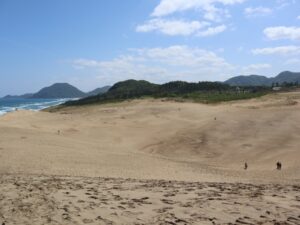
Photo by soraosraさん
Don’t forget to check out the Tottori Sand Museum for a unique art experience. New exhibits open in April and are on show until January of the following year. The museum then closes for three months to allow artists from all over the world to create their new works.
Recent exhibits are part of the ‘Travel Around the World in Sand’ series; themes include India, South America, and Scandinavia. (2020-2021’s theme was Czechia and Slovakia). The museum really is a delight for both art and sand castle lovers alike! And if you really want some sand, don’t miss the famous Tottori Sand Dunes, one of several Japanese “deserts”.
Summer
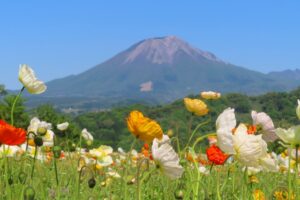
Photo by ぴーうささん
If spring is for cherry blossoms, summer is for festivals! Tottori prefecture is home to some unique festivals and summer events. The first weekend in June kicks off the opening of climbing season on Houki’s Fuji, aka Mt Daisen, with a parade of almost 2,000 torchbearers. At 1,729 meters Daisen is the highest peak in the Chugoku region. Home to beautiful trails, Daisen attracts serious hikers as well as more casual forest-bathers. Don’t miss Daisen-ji Temple, completed in 718, parts of which are designated National Treasures of Japan!
The nearby Masumizu Highlands are the sight of Ji-Beerfest Daisen, a gathering of Japanese musicians and microbreweries from all around the country. There is free transportation not only from the station, but also between the venue and the campsite, which is also free for all festival goers. The festival is held over a weekend in early to mid-June.
The name of the Gaina festival in Yogano comes from the local dialect word meaning ‘big’, in reference to the towering rows of lanterns carried in the parade. There is also a Taiko performance for Japanese drum lovers and the two-day festival ends with a BIG fireworks display. Around 6,000 fireworks are set of during the festivals climax! The Yagano Gaina festival is held in late July or early August.
During Obon, the streets of Tottori fill with spectators for the world’s largest umbrella dance! The Shan-shan Festival’s Bon odori, in reference to the onomatopoeia for the sound of a bell ringing, involve large paper umbrellas adorned with small bells that shake and jingle during the dancing. About 4,000 people join the dance every year, in mid-August.
Autumn
Autumn’s claim to fame is, of course, the changing leaves! Thanks to Daisen, Tottori can claim some of the most beautiful viewing spots for fall colors in Western Japan. The leaves start changing color in early October, but the peak season is mid-October to early November.
But Daisen is not the only sightseeing destination for fall visitors! Senjodaki Waterfall, in Mitaki Gorge, is surrounded by forest. There is even a Japanese style red suspension bridge above the valley making the whole area a scenic fall foliage spot.

Photo by 風間絆名さん
Utsubuki Park is also a great place (all year) to get out and enjoy nature. With cherry blossoms (spring), azaleas (summer), and camellias (winter), this park is a great place to get out and walk in every season. November is the start of crab season. And crab in Tottori is big deal.
Tottori people consume more crab than people from any other prefecture. They rank number one with the Ministry of Agriculture, Forestry and Fisheries, bringing in over 7,000 tons of all kinds of crab; almost double than of Hokkaido, in second place. Tottori has even created its own luxury brand of Matsuba crab, Itsukiboshi. (An Itsukiboshi crab has set the world record for the most expensive crab sold at auction, selling for 5 million yen!)
Winter
If the Sand Museum was any clue, Tottori can boast one of the finest coastal sand dunes in the country. They also host the largest illumination even in the San-in region, illuminating the area around the dunes from early December to Christmas. (Tottori’s Hanakairo Flower Park also holds an illumination event from early November until late January.) Come for the illuminations, but stay for the camel riding, paragliding, cycling, and sandboarding!
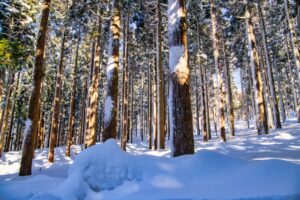
Photo by 自然さん
Last but not least, skiing! With over 11 kms of slopes across 7 ski resorts, there is a ski resort for everyone. It’s no Hokkaido, but from a day out on the slopes to a night enjoying the illuminations and stargazing at the dunes, Tottori offers a truly unique vacation experience. And if you want a little danger in that experience, check out Japan’s most dangerous National Treasure, Nageiredo Temple, on the cliffs of Mount Mitoku!
Whenever you decide to visit, Tottori is a great place to make your next vacation destination!
Photo Credits:
Top photo: Toby Sakata on Unsplash
Additional Photos (all from PhotoAC)
Spring – soraosraさん
Summer – ぴーうささん
Fall – 風間絆名さん
Winter – 自然さん
All other content (text) created by the original author and © 2022 MUSUBI by Borderlink
Top photo: アオウミガメさん on PhotoAC
Be sure to read Part 1 of this article first!
Highlights of our first trail
I found myself basking in the arms of nature’s divine creation. The towering age-old giant trees, their roots outstretched for what felt like miles, forming the narrow bridges and tiny lanes leading the pathway. The squawking of birds and rustling of leaves as wind gushed through them filled the fresh air.
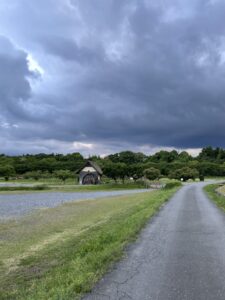
Photo by Anmona Handique
This portion of our journey was a rough 20 minutes’ walk, followed by a satisfying breath of relief and celebration of the first leap. After crossing the timbered forests, we walked down a road and then back up into the woods again. After walking a decent 10 minutes, we approached another main road following the sign boards that were marked in kanji for Kinchakuda.
We came across some picnic benches meant for hikers to sit for a while and eat or snack. However, we didn’t take a stop as we were still stuff on burgers, so we continued on.
Route to Kinchakuda
After that fulfilling forest walk, we came across the main connecting route to Kinchakuda. We kept walking and soon found ourselves once again in nature’s heavenly arms. We crossed a tiny wooden bridge over a river that further led the way to Kinchakuda. We were able to touch the water of the river; it was refreshing and mildly warm.
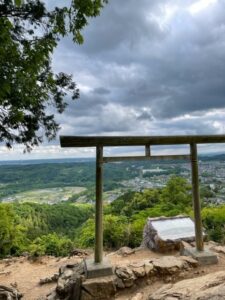
Photo by Anmona Handique
It is said that depending on the time of the year you visit, you get to see the seasonal changes. Unfortunately, we missed both the sight of cherry blossoms and autumn leaves. But nonetheless, it was still worthwhile to go when we did. We came across some restrooms that were super clean and plenty of benches to take a breather on.
After a brief pause, we again started again. We were completely in awe of the breathtaking view of the entire emerald landscape that covered the Kinchakuda Manshu Syage Park area What a beauty it was!
Highlights of Kinchakuda
The Kinchakuda area has much to enjoy: seasonal flowers, countryside Japanese houses, fresh summer grasses and graceful hanging branches. There’s luscious green crop fields, rivers full of fish, ponies mulling about on farms, and a vintage water mill. With just the sight of families having picnic parties near the flowing river, we all knew we were in some sort of dreamy landscape under the scintillating sun. I wondered how it had taken us so long to learn about this heavenly land. Indeed, a must-go-place!
Going Up Mount Hiwada
Well, after crossing the heavenly trails of Kinchakuda, we finally marched toward some real hiking action: about 305 meters that led up to Mount Hiwada. In a few blogs, I got to read that while traveling to Hiwada we may spot (and be able to sample) some home-grown organic vegetables. Alas, we missed them. Better luck next time!
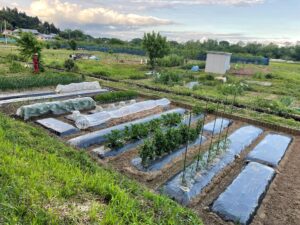
Photo by Anmona Handique
After walking for some time in the neighborhood following the trail, we also came across some old barren concrete houses that seemed quite spooky. Perhaps they were even haunted! After some time, as we finally entered the way up to our final destination towards Mount Hiwada. We came across the famous Alisan Organic café that lies on the edge of Kinchakuda; this is something that I have read about many times in few blogs.
However, we didn’t have sufficient time to take a quick sneak-peek into the café and therefore continued our walking trails. We soon found ourselves back in the woods, but now things were comparatively much steeper and sparse. With all our energy, we started climbing one step after another. This hiking phase was a tiring one and not easy like the earlier trails we have covered so far. But slowly and steadily, we did it.
Highlights of the climb
There were two routes that can be taken up in to the woods – one is Dansei– “for men” and another is Josei – “for women”. But again, being our first time and with a confusing google map we really missed this part and chose the rougher Dansei route. But it was again a fulfilling one, as finally I succeeded in traversing the toughest parts of the entire trail.
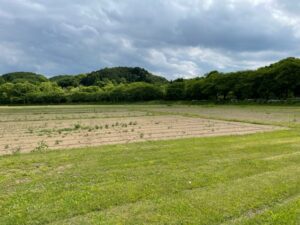
Photo by Anmona Handique
We also came across other hikers who were found retracing their steps back through the woods. We were also stunned to see a lively gang of seniors trying rock climbing! Another inspiring sight it was. After a long hike for quite some time, we reached one of the peaks, although not the topmost one. Although we got a pleasant view, we knew we weren’t at the end just yet.
The main lesson of my hiking experiences was that no matter how steep or how tiring it might be, once you reach the destination you will feel that sense of completion. If you have decided in your mind to accomplish something and then do so, you instantly forget your fatigue and expended energy. All you are are left with is just the ultimate peace of mind and soul.
The final trail
This was the best part and the sense of satisfaction we got after a good hike of about 3 hours was sublime. After a vigorous hike of steep stairs, we thought we have reached the final peak. We realized we had already climbed up quite high and we could catch some scenic views of Tokyo. But then we saw another group of old hikers who were combing down a cliff. By the time we were wondering from where they might be coming from, one of them came smiling to us and told us, “Just 5 minutes more, don’t give up”.
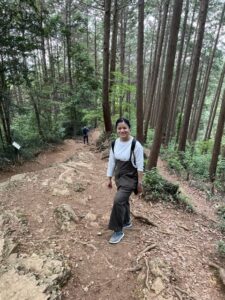
Photo by Anmona Handique
And those words at such a moment really turned into a blessing in disguise. We channeled all our energy back again and dared to climbed up the steep stairs luring us. The more and more we kept climbing, huffing and puffing, the more we felt energized rather than being tired. Deep down we knew we were almost there. Just a few steps more! And after a rough 5 minutes of climbing, we were there. We had done it!
We found the Tori gate that marks the gateway to the top peak of Mount Hiwada. And what a spectacular view it was! I realized then how hiking can be so beautiful and fulfilling, and that it really has the power to bestow the ultimate satisfaction in life.
After taking some photographs of the mesmerizing landscape, we passed the Tori gate and finally we reached the zenith of Mount Hiwada. We all heaved a euphoric sigh, a feeling that still keeps me motivated and alive. We sat on the benches placed up there, and with such a gorgeous view in front of our eyes, we finally munched our convenience store food. After that trek, it tasted better than ever. After finishing our snacks and enjoying the breathtaking conclusion of our first hiking stamp, we headed home. We were now filled with inspiration to further explore the many hiking trails of Japan.
I hope my hiking experience has motivated you to ask the same question I once did – “Should I embrace the hiking culture in this beautiful country of Japan?”. I would say that you definitely should
Photo Credits:
Top photo: アオウミガメさん on PhotoAC
All additional photos provided by Anmona Handique, used with permission
All other content (text) created by the original author and © 2022 MUSUBI by Borderlink
Top photo: shiro15さん on PhotoAC
Should we embrace the hiking culture in Japan?
From its majestic breathtaking landscapes to its dazzling skyscrapers; from the alluring neon corridors to its enticing cuisine; from the serene shrines and temples to the soothing bamboo forests, one thing is certain: Japan always has so much to offer and explore. And among all the alluring options available, recently I chose hiking as one of my new hobbies to experience the vibrant hiking culture in Japan.
But why hiking?
At the end of the day, living in such a complex and cutting-edge competitive environment, all we crave for a peaceful, happier and a healthier life. And to me, hiking is one of the activities that I believe would further help me to restore my sanity and do justice to my immune system especially in today’s often-harassing atmosphere of Covid-19 and economic uncertainty.
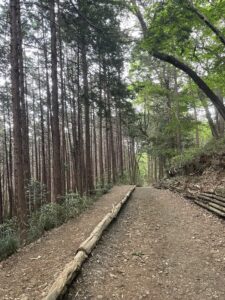
Photo by Anmona Handique
Hiking is not only a fun adventure, but a gratifying way to build relationships with your body and to the outdoor world, spending quality time with nature, mountains and the emerald landscapes. Hiking could be a magical potion for your cardiovascular health such as maintaining balanced blood sugar levels, cholesterol and blood pressure. It also acts as a remedial antidote for building the muscles, bone density, stamina, dealing with day-to-day stress and nourishing the overall mental well-being.
Today, if you browse the internet, you will definitely get a plethora of the benefits of hiking. But the true experience can be felt if and only if you set out on a real trek, and experience the unexperienced parts of nature first-hand.
Not that I was not an outdoor person, because travelling is something I always love to do. But serious hiking was something quite different to an amateur like me. And I would say, the entire concept of hiking indeed differs from a normal walk. Maybe the constant demand for both physical and mental work-outs simultaneously was the reason that made me hesitant about hiking initially. But believe me, these hiking trips have turned out to be one of the most profound experiences of my life so far. Hence, I would like to share every bit of my experience through this blog. But let’s start with my first hike!
As a beginner, here’s a tip!
So, for the initial hike we were three people- me, my better half and a friend of ours- all novice hikers, but all enthusiastic enough to explore our first hiking trail. Being new to the art of hiking, we thought of making our first trek an easier one. Thanks to the numerous & inspiring hiking blogs of Japan with the many helpful tips, we did the research and chose to hike the trail that leads to Kinchakuda and Mount Hiwada nestled in Saitama prefecture.
Not all are aware of this gorgeous location, but it might be more popular among the local residents of Tokyo. This hiking spot was more of a leisurely stroll in the beginning, although towards the end it required some real hiking skill, but not as energy-intensive as others. So, from our experience, I would suggest an easier trek for your first hiking adventure, and this is a pretty good one to go with.
Now, how to commute and what to know before hiking?
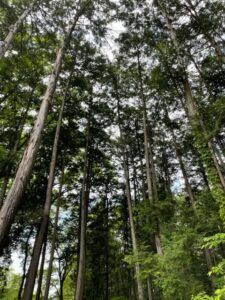
Photo by Anmona Handique
Having our home close to Nishi-kasai, we boarded our first train from Nishi-kasai station to Ikebukuro station (around 250 yen). Then from Ikebukuro station we took the Seibu-Ikebukuro line and got off at Hanno Station, taking the limited express that costs around 980 yen. From Ikebukuro station to Hanno, it took us around 45 minutes. Once you get off from the Hanno Station, just take a North exit, take to the main road going by the north direction and get ready to explore the western mountainous region of Saitama prefecture.
Before leaving Hanno station, we bought some food from the convenience store that was located inside the station- we went with some sandwiches, onigiri (Tuna-mayonnaise rice balls), and some juice. Keeping a good stock of food is always essential when you are going for longer hikes, as you will work up an appetite and need an energy boost or two along the way. Then we found some hiking maps in the station. All were printed in Japanese, but Google Maps helped to pick up the slack for our less-fluent group.
By the way, here are some important highlights, before you start the walking trail.
The Altitude of Mount Hiwada: 305 meter
Difficulty level: Easy to slightly difficult towards the end
Time to visit: All time, however spring and autumn is the best
Hiking time: 2.5 to 3 hours
Final Station to get off at: Hanno Station, Saitama
Entering into our first walking trail!
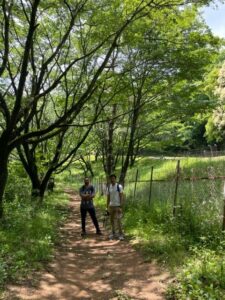
Photo by Anmona Handique
So, it was in the month of May and thankfully the weather was kind to us on that day. It was a quiet neighborhood. The city was brimmed with plenty of sunshine bordering the beautiful houses with small balconies, pretty gardens, and small roadside shops. From a distance we also saw one or two malls amidst the Japanese restaurants housed near the corner of the main roads.
By that time, it was 11 am and yes, we got a little late to start our hike. Before heading into the woods as suggested on the map, we came across a huge “Mac D” and thought of stuffing some burgers as we were already famished travelling all the way from Nishi-kasai. And gradually, with a happily full tummy, we headed towards the woods.
For a novice hiker like me, going into the woods for real did seem a daunting task initially. As we kept walking up the trails deeper and deeper into the woods though, it turned into a truly a unique experience…
Come back for the conclusion this Friday!
Photo Credits:
Top photo: shiro15さん on PhotoAC
All additional photos provided by Anmona Handique, used with permission
All other content (text) created by the original author and © 2022 MUSUBI by Borderlink
If you are interested in bread or deep fried snacks, then this is the food for you! Japanese curry bread (kare pan) is the perfect blend of sweet and savory. This soft, chewy and crispy deep-fried snack is popular all over Japan. Convenience stores, bakeries and even supermarkets all sell this tasty snack. Most places deep fry bread dough, use panko (Japanese bread crumbs) meat and vegetables.
Of course each place has it’s own unique twist and secret recipe. From adding cheese to sometimes baking the bread instead of frying, the sky is the limit. They are even in popular culture, with Currypanman being found in the famous Anpanman show. Either way, they all taste delicious and are super cheap.
A brief history
Curry was first introduced to Japan in the 19th century by the British via India. But, it wasn’t until 1927 for the first curry bread to be born. It is said, that the owner of Cattlea decided to deep fry curry, and “accidentally on purpose” invented curry bread. Here are a few recommended places in the Tokyo area.
Cattlea (Morishita)
“Ganso curry bread, Cattlea” was first established in 1927. They claim to be the first and original curry bread in Japan. The bakery is literally a one minute walk from Morishita station on the Oedo/Shinjuku line. There are two different curry breads to try here, an extra dark and spicy one or the original curry bread.
Each curry bread is crammed full of ingredients, the taste is rich and creamy. It’s like heaven when eating it and you can never just have the one. In my opinion this is the best curry bread you can eat. They make fresh curry bread at 7 am, 11 am and 3 pm, you have to be quick, as they literally fly off the shelves.
Curry bread price – 200 yen
Denmark Bakery (Nerima)
It is also said that the Denmark bakery in Nerima, invented curry bread in 1934. They were originally selling curry sandwiches but decided to deep fry them. The bakery is a one minute walk from the Nerima station on the Seibu line. The bakery has lots of choices from birthday cakes to cured meats, so you can have a sweet snack after munching your curry bread. The bakery is famous for adding a hard boiled egg to their curry bread. The bakery is very busy during lunch time, so you have to be quick!
Curry bread price – 270 yen
Boulangerie Seiji Asakura (Minato)
The bakery is a 5 minutes walk from Takanawadai Station on the Toei Asakusa Line. This bakery has been on the TV and has won many awards for its bread. Their curry bread is topped with lots of cheese and they use beef. They’re huge and the cheese adds great flavor and the beef is nice and spicy.
Curry bread price – 330 yen
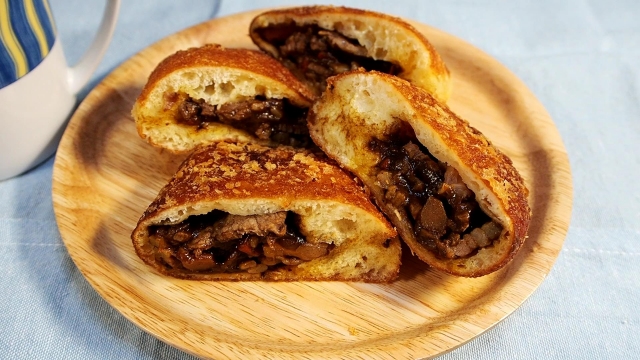
Photo Credit: ringonomeさん on PhotoAC
Go for a walk and start eating
There are so many different curry breads to choose from and so many different places. You could spend a whole day in Tokyo alone, just walking around and snacking on curry bread. And remember, on the 8th day of each month is curry bread day. So now you even have an excuse, to go out and get your taste buds curry punched!
Photo Credits:
Additional photo: ringonomeさん on PhotoAC
All other content (text) created by the original author and © 2022 MUSUBI by Borderlink
Kyoto has always been my favorite place in Japan. However, while I appreciate the major temples at the top of every tourism brochure, the best area is just slightly off the main path. If I could spend one day anywhere in Japan, it would be in Arashiyama.
Arashiyama is a suburb on the western edge of Kyoto. It’s where the last bit of the city crashes into the mountains. Cherry blossoms drown out the landscape in the spring, it is painted in shades of orange in the fall, and endless rows of bamboo stand guard all year long.
Perhaps the most photographed forest in all of Japan is the Sagano Bamboo Grove. Despite running parallel to the main city street, the bamboo walls block out any trace of modernity. You may recognize it as nearly every martial arts training montage is filmed here. When you aren’t finding your inner warrior, it’s great for a refreshing walk or a romantic journey.
Just down the road from the bamboo forest and the massive Tenryu-ji temple adjacent to it is an old fashion bridge. This is Togetsukyo, a bridge so wonderful that even the moon likes to cross it (which is how it got its name). It was originally built in 836, and while it has been updated several times in the centuries since, it keeps its old age charm. If you are really brave, go out on a night boat and watch traditional fishing done by cormorant birds.
When the bridge ends, the mountains begin. While climbing Arashiyama itself is a tough task, you should definitely go up Iwatayama, better known as Monkey Mountain. After about a twenty minute hike up a fairly easy mountain path (it is still a mountain, so do be a little prepared), you’ll reach a camp populated with around 170 Japanese Macaques.
These monkeys have lived near humans all their lives, so they are quite calm and will get very close to the visitors. There’s also a place where people can feed the monkeys. They take the food gently out of our hands. Don’t forget to turn around from the monkeys and look over the side of the mountain to see a picture perfect view of all of Kyoto.
Finally, in between these three great places are a ton of Japanese shops and restaurants. This includes several homemade craft malls if you want to buy an authentic piece of Kyoto. Arashiyama is famous for it tempura, and there’s plenty of great choices on that front. However, the area is also home to Steak Otsuka, a place voted the best restaurant in Japan. It serves a mouthwatering wagyu beef, specially selected from only 80 cows every year. Get there early, because there will be a line.
Arashiyama is a fantastic place to spend a day. But if you wanted to see more of the surrounding areas of Kyoto, Nara, Osaka, and the rest of Kansai, it’s also a great hub. In just the past few years, they have built several large hotels nearby, and for a much more affordable price than in downtown Kyoto. The town is surrounded by three train stations, taking just 10 minutes from Kyoto Station, 20 minutes from the Gion area, and a pretty straight shot to Osaka.
Arashiyama is my absolute favorite area in Japan. No trip around the country is complete without it.
Photo Credits:
Additional photo: photo7さん on PhotoAC
All other content (text) created by the original author and © 2022 MUSUBI by Borderlink
Top Photo: himawariinさん on PhotoAC
One of the main things I’ve utilized since living in Japan are convenience stores, otherwise abbreviated as konbini. Not only are convenience stores in Japan useful, but they are also practically available anywhere. There are a variety of different convenience stores in Japan such as Seven-Eleven, Lawson, and Family Mart. Each convenience store has its own flavor, goods, and services to suit consumer tastes.
Here’s what to know about picking the right convenience store for you!
What are convenience stores?
Convenience stores are small retail shops that carry a variety of foods, snacks, drugstore items, and packed lunches. They are often found around train stations and residential areas. Convenience stores as the name suggests are made for convenience and provide many services as well. Such services include Wi-Fi, bill payments, ticket reservations, ATMs, and scanners/printers.
Types of Convenience Stores
There are many types of convenience stores but to keep things simple, I will focus on the most widespread and common convenience stores. The largest chain is Seven-Eleven with 20,988 stores throughout Japan, Family Mart is the second largest with 17,409 stores, and lastly, Lawson with 14,000. Besides the larger convenience store chains, there are also smaller ones to mention such as Circle K Sunkus, Ministop, and Daily Yamazaki.
Seven-Eleven is known for its fresh food and fast services. It generally has higher quality than the convenience store chains and a wider range of products, including pet food and lifestyle essentials. Seven-Eleven is targeted elderly customers because of the lightly seasoned food. Salads and bread are popular items at Seven-Eleven.
Lawson is known for being more aesthetic, focusing on nutrition and representation. Their sweets are very popular amongst women and children as they are very cute and visually appealing. Natural Lawson, a chain of Lawson even sells fresh fruits, focusing on organic and naturally sourced products. Some popular items include waffles, parfaits, and pudding.
Family Mart is popular amongst men for desserts and snacks with larger portion sizes. Family Mart is known for having the best hot foods amongst the chains with their own brand of karrage, “Fami-chiki” being quite famous in Japan. Even so much as to develop its own fan base. Popular items at Family Mart are bentos (lunch boxes) and spam musubi.
I hope that this article helped you understand the convenience store culture here in Japan. If you visit Japan, please check them all out!
Looking to find your preferred convenience store brand? Find out more about how to live and work in Japan as an Assistant Language Teacher!
Photo Credits:
Top Photo: himawariinさん on PhotoAC
All other content (text) created by the original author and © 2022 MUSUBI by Borderlink
One of our contributors shares a little about a place they used to live, and the place they live now!
Introduction
It is nice to live in a new place. Before I moved to Japan, I lived in Lagos, Nigeria, an area known for being a bit crazy. There’s a lot of people, and a lot of traffic! For those looking for something quiet, it’s not going to be their first chocie.
In my first few months in Japan, I lived in Odaiba, not far from central Tokyo. It wasn’t difficult adapting to life in Odaiba for me, as it is an area that attracts people from all over.
Lots of tourists often visit Odaiba, especially during summer. There’s the huge Gundam statue, the famous rainbow bridge, and a miniature Statue of Liberty. Odaiba has really cool shopping centers (Venus Fort!), Madame Tussauds, and Legoland. Plus, the world’s second-biggest Ferris wheel, awesome theme parks and Showa-themed shops… and a totally breath-taking view of course. It was like living in paradise. At the time, I wished every other part of Japan could be like Odaiba. And then, I moved.
Coming to Hachioji
I had this huge expectation moving to Hachioji in western Tokyo. I hoped it would be somewhat close to Odaiba. The new neighborhood was a remote area in Hachioji and much quieter. I was quite disappointed in my first few weeks in Hachioji, because it was so different. The Hachioji apartment I lived in was older and smaller than the one I had before. The rent was much more affordable, but I missed my old place and my old life.
But with time, I was finding that I didn’t allow this ‘disappointment’ to discourage me. Instead, I was hunting for fun places in Hachioji. I realized that there were in face plenty of things to see and do here.
Things to See
If you are a nature lover, then there is Mount Takao. Mount Takao is 599 meters or 1,965 feet tall, and from it one can see the famous Mount Fuji.
There are also a number of museums in the area. These include the “Tokyo Fuji Art Museum”, “Kinunomichi Museum”, “Takaosan Tric Art Museum” and “Takao 599 Museum”.
We also also quite a few parks in the area. They are the “Ryonan Park”, “Fujimori Park”, “Takiyama Park” and “Komiya Park”. Sometimes, if you want to clear your head and feel good, there are GREAT places to visit like ‘Hachioji Castle Remains’, ‘Musashi Imperial Graveyard’ and ‘Tama Forest Science Garden’.
Places to Learn
For those who would like to study Japanese, there are two places in Hachioji where one can go and study for free. These are the ‘Hachioji Square Building’ and ‘Create Hall’ which are both close to Hachioji station.
For people who love dancing, there are a good number of dance studios also in the vicinity of the station. If you’ve ever wanted to take up dancing lessons, Hachioji is as good as place as any!
After the Sun Goes Down
How about a nightlife? Hachioji has that too! I recommend places like ‘British Hub’, ‘Red Flame’ as well as ‘Bar Lounge’ to have a good time. It’ll be a different experience than central Tokyo, but an equally enjoyable one.
Looking for a bite? If you are a Ramen fan like me, you should try Hachioji ramen. It is one of the tastiest ramen variations I’ve had, and there’s over 20 restaurants in the area that serve it.
Finally, house rents and transportation are quite cheap here in Hachioji compared to what there is in central Tokyo. If you’re looking for a place to hang your hat and commute into central Tokyo, Hachioji is a great place to do it.
Conclusion
Hachioji is one of the biggest cities in the Greater Tokyo Area, and after several years living here, I love it as much as I did Odaiba. Maybe even more! I believe there’s plenty more to see and do beyond what I described. Come to Hachioji and discover your own adventures, for it’s a great place to visit- or to live in!
Photo Credits:
All other content (text) created by the original author and © 2022 MUSUBI by Borderlink
Top Photo: Shinjuku Gyoen National Garden, Tamamo pond. Photo Credit: Maurice R. Daniels
A Cheaper Alternative to Enjoying a Weekend!
So here is the dilemma: You are living in Japan, and you are bored over the weekend. However, you know that you want to save money, and Tokyo Disneyland or even a movie at your local theatre could be something that you do not want to pay for.
Perhaps there is a solution? In truth, there are many ways that many people, new to Japan, can find enjoyment outside. As we go into warmer months, many will want to spend their time safely, while avoiding costly places. In this article, we’ll look at different ways to enjoy your time in Japan and increase your value of your stay here.
Japanese National Parks and Recreational Areas
The first one that I would like to bring up, may or may not be an obvious one. Perhaps some people feel like going to a park might be a waste of time. But if you really think about it; surrounded by the concrete jungles of Tokyo, where you might only see vegetation every now and then, a park might be just the place you need to relax and enjoy beautiful gardens and flowers. My suggestion to everyone is to go to a beautiful park that is entirely inexpensive, known as the Shinjuku Gyoen National Garden.
This park is just a short walk from the south exit of the Shinjuku JR line, and only costs a mere 500 yen to enjoy beautiful gardens and relax in a very green and beautiful setting. While that might seem a little expensive, you are helping them keep up the park, and its cheaper than a movie. Depending on your preferences, it might even be much more beautiful.
Also, I must admit; there is a free path that takes you around the park itself. There, depending on the year, you can find beautiful trees and a lovely overpass of vegetation above you. I walked around the park before heading in, and it brought me a bit of peace. I do recommend going inside the park, but I believe that the outside is just as worth it.
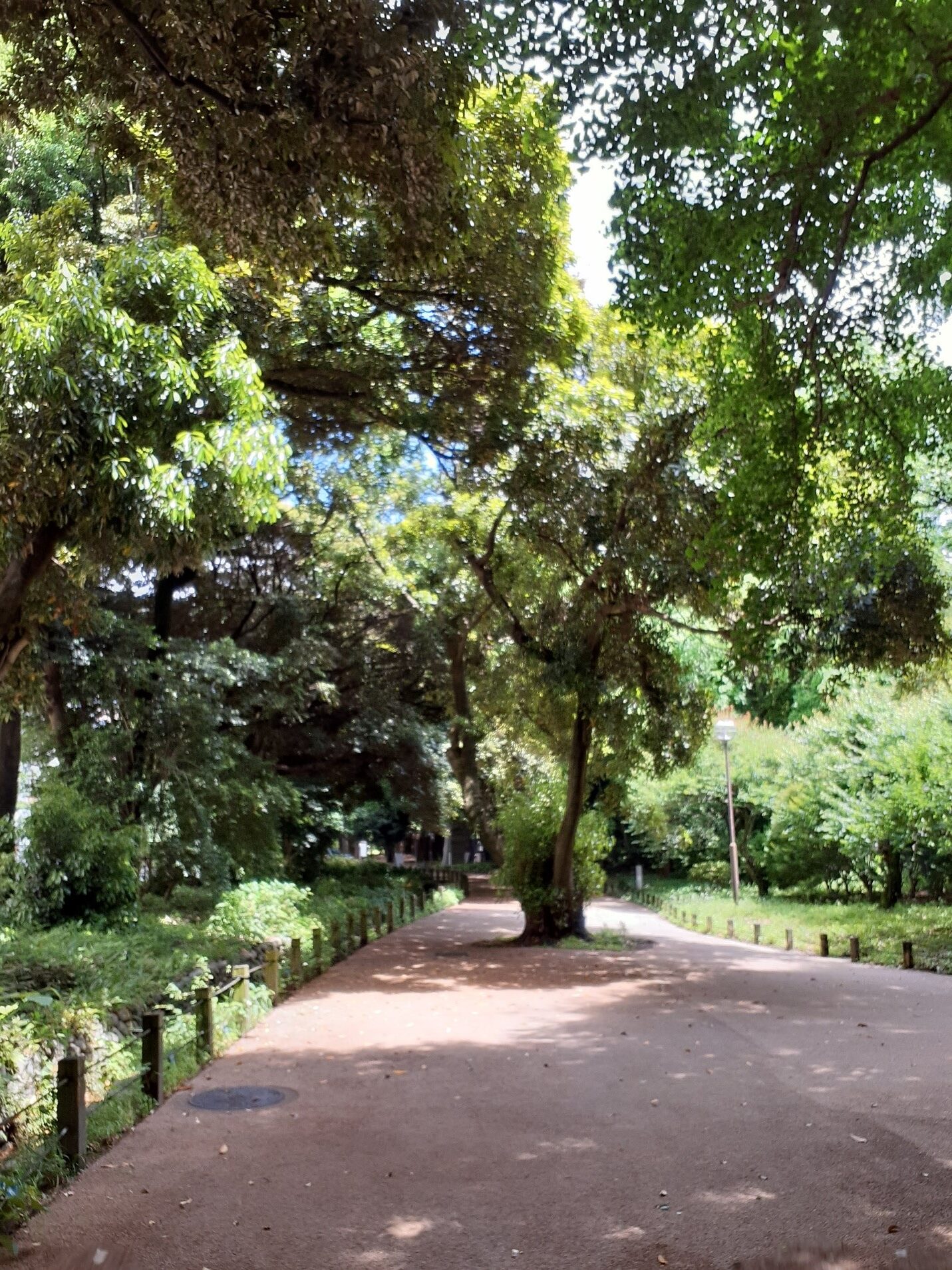
The path outside of the Shinjuku Gyoen National Garden. Photo Credit: Maurice R. Daniels
There are many beautiful places to go where the nature scenes are profound, in my opinion. I was recommended a place known as Ashikaga Flower Park, where many beautiful flowers can be found. While the fee might be 1000 yen, it’s still cheaper than a movie at Aeon, which can be much more.
Japanese Temples
Visiting the local temples and shrines might be one of the cheapest alternatives that you can find. When visiting to Japan, I have always loved to go and see some of the most beautiful shrines and temples that I could ever visit. I have visited many in span of four visits to Japan, and I must go to the famous shrine near me, Orihime shrine sometime soon. I have been to Kamakura Hasedera shrine, Sennoji Temple in Asakura, the Meiji Temple in Tokyo, and many more.
While temples might not be for everyone, it is a great place to go and spend a day. You could visit one major shrine, or just visit your local shrine itself. There are many shrines that are free, and even the temples and shrines that require a fee are inexpensive. I prefer going to temples as a free and safe alternative then to going to a pricey attraction, as I prefer the beautiful architecture and tradition to other pricier ‘tourist traps’, as they can sometimes be called.
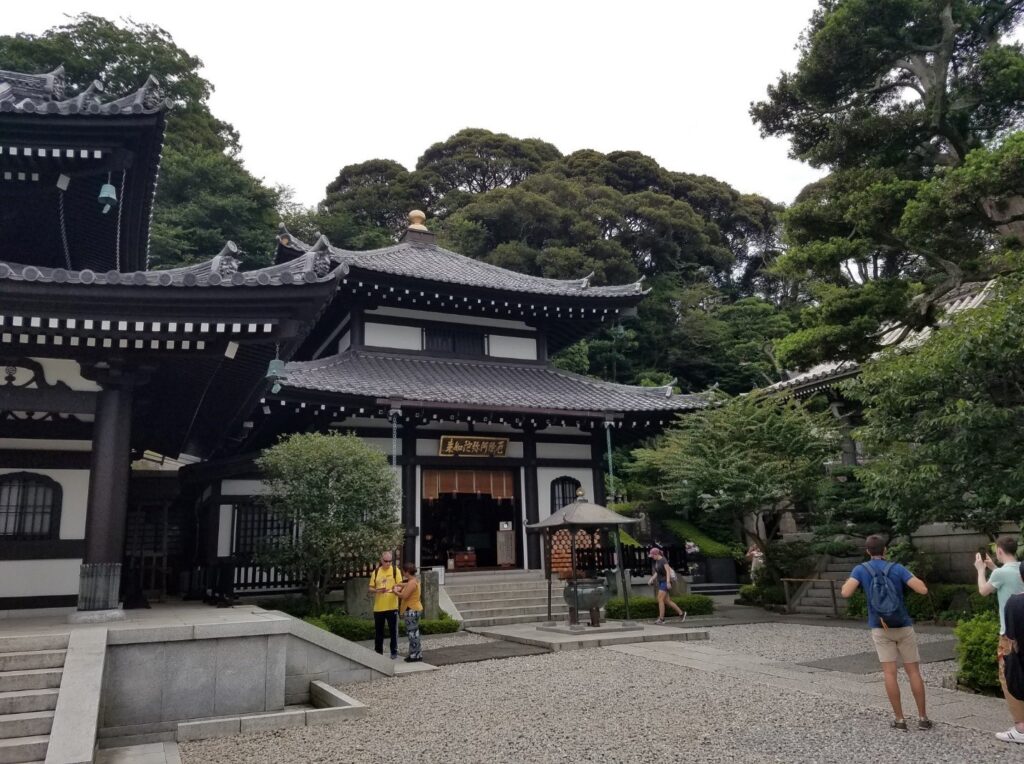
Kamakura Hasedera Shrine. Photo Credit: Maurice R. Daniels
Japanese monuments and attractions
Perhaps shrines and parks aren’t for you? Perhaps you would like to visit places of history instead? While there are some great, but pricey tourist spots, you might wish to go to places such as the giant sitting buddha statue in Kamakura. There are also beautiful castles in almost every major city and town.
I went to Odawara Castle Park in 2019 and enjoyed the beautiful castle and it’s surrounding features for cheap, and I felt very cultured and at ease while visiting there. I was brought there by friends, and I am glad that I went. I believe that these places can be a great place to find the jewels of Japan, and you can truly feel the beauty and craftmanship through these sites.
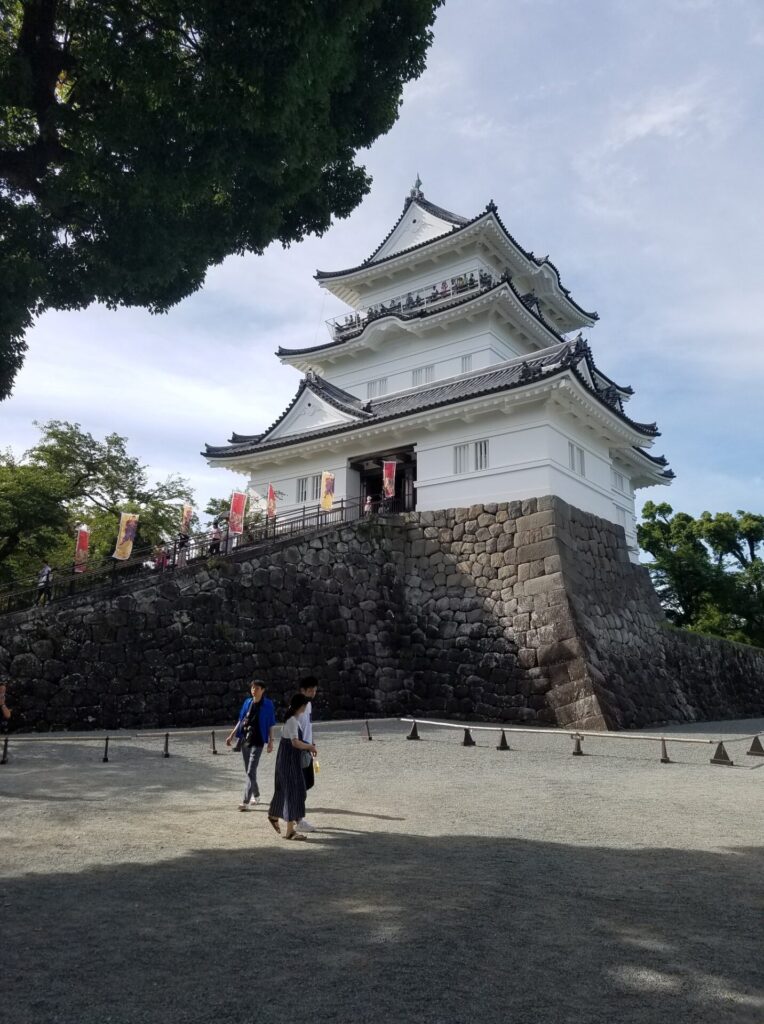
Odawara Castle Park. Photo Credit: Maurice R. Daniels
In Conclusion…
In conclusion, I believe that there are many places that one can visit, without stressing over how much money they will be spending. While its true, traveling there might cost a bit of money (depending on where you live), I can almost guarantee that if you look around where you live and/or visiting, you can find cheaper, safe, and alternative places to visit, instead of going to a large tourist spot that that could possibly cost you a lot of money.
Now, don’t get me wrong. You can definitely go visit Tokyo Disneyland, or a waterpark, or some grandiose place if you want. In fact, visit it once, enjoy it, and log it as a wonderful experience. But it can get expensive if you go often. So instead, look for a cheaper alternative, and visit some of Japan’s finest architecture and national spots. I hope you find a place that truly gives you some peace of mind.
Photo Credits:
All photos taken by Maurice R. Daniels and used with permission.
All other content (text) created by the original author and © 2022 MUSUBI by Borderlink

